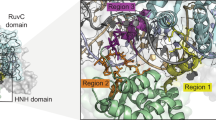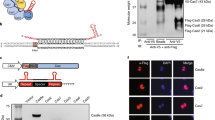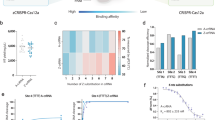Abstract
Cas9-based technologies have transformed genome engineering and the interrogation of genomic functions, but methods to control such technologies across numerous dimensions—including dose, time, specificity, and mutually exclusive modulation of multiple genes—are still lacking. We conferred such multidimensional controls to diverse Cas9 systems by leveraging small-molecule-regulated protein degron domains. Application of our strategy to both Cas9-mediated genome editing and transcriptional activities opens new avenues for systematic genome interrogation.
This is a preview of subscription content, access via your institution
Access options
Subscribe to this journal
Receive 12 print issues and online access
$259.00 per year
only $21.58 per issue
Buy this article
- Purchase on Springer Link
- Instant access to full article PDF
Prices may be subject to local taxes which are calculated during checkout


Similar content being viewed by others
References
Doudna, J.A. & Charpentier, E. Science 346, 1258096 (2014).
Hsu, P.D., Lander, E.S. & Zhang, F. Cell 157, 1262–1278 (2014).
Gantz, V.M. & Bier, E. BioEssays 38, 50–63 (2016).
Chen, B. et al. Cell 155, 1479–1491 (2013).
Hilton, I.B. et al. Nat. Biotechnol. 33, 510–517 (2015).
Dominguez, A.A., Lim, W.A. & Qi, L.S. Nat. Rev. Mol. Cell Biol. 17, 5–15 (2016).
Nuñez, J.K., Harrington, L.B. & Doudna, J.A. ACS Chem. Biol. 11, 681–688 (2016).
Nguyen, D.P. et al. Nat. Commun. 7, 12009 (2016).
Oakes, B.L. et al. Nat. Biotechnol. 34, 646–651 (2016).
Iwamoto, M., Björklund, T., Lundberg, C., Kirik, D. & Wandless, T.J. Chem. Biol. 17, 981–988 (2010).
Miyazaki, Y., Imoto, H., Chen, L.C. & Wandless, T.J. J. Am. Chem. Soc. 134, 3942–3945 (2012).
Banaszynski, L.A., Chen, L.C., Maynard-Smith, L.A., Ooi, A.G. & Wandless, T.J. Cell 126, 995–1004 (2006).
Moore, C.L. et al. ACS Chem. Biol. 11, 200–210 (2016).
Shoulders, M.D., Ryno, L.M., Cooley, C.B., Kelly, J.W. & Wiseman, R.L. J. Am. Chem. Soc. 135, 8129–8132 (2013).
Perez-Pinera, P. et al. Nat. Methods 10, 973–976 (2013).
Balboa, D. et al. Stem Cell Rep. 5, 448–459 (2015).
Konermann, S. et al. Nature 517, 583–588 (2015).
Zalatan, J.G. et al. Cell 160, 339–350 (2015).
Zetsche, B., Volz, S.E. & Zhang, F. Nat. Biotechnol. 33, 139–142 (2015).
Nishimasu, H. et al. Cell 162, 1113–1126 (2015).
Esvelt, K.M., Smidler, A.L., Catteruccia, F. & Church, G.M. eLife 3, e03401 (2014).
Davis, K.M., Pattanayak, V., Thompson, D.B., Zuris, J.A. & Liu, D.R. Nat. Chem. Biol. 11, 316–318 (2015).
Tsai, S.Q. & Joung, J.K. Nat. Rev. Genet. 17, 300–312 (2016).
Zuris, J.A. et al. Nat. Biotechnol. 33, 73–80 (2015).
Kim, S., Kim, D., Cho, S.W., Kim, J. & Kim, J.S. Genome Res. 24, 1012–1019 (2014).
Fu, Y. et al. Nat. Biotechnol. 31, 822–826 (2013).
Schneeberger, K. Nat. Rev. Genet. 15, 662–676 (2014).
Hsu, P.D. et al. Nat. Biotechnol. 31, 827–832 (2013).
Ran, F.A. et al. Nat. Protoc. 8, 2281–2308 (2013).
Acknowledgements
This work was supported by the NIH (Director's New Innovator Award 1DP2GM119162 to M.D.S.; grant 1R21AI126239-01 to A.C.), the Edward Mallinckrodt, Jr. Foundation (Faculty Scholar Award to M.D.S.), and the Burroughs Wellcome Fund (Career Award at the Scientific Interface to A.C.). C.L.M. acknowledges the National Science Foundation for a Graduate Research Fellowship. We are grateful to B. Harvey (NIDA) and to I. Slaymaker, F.A. Ran, and B. Wagner (Broad Institute) for helpful discussions. J.K. Joung (Harvard Medical School, Boston, Massachusetts, USA) provided U2OS.eGFP-PEST cells. This work is dedicated to Professor Stuart L. Schreiber on the occasion of his 60th birthday.
Author information
Authors and Affiliations
Contributions
B.M., C.L.M., B.Z., M.D.S., and A.C. planned research and analyzed data; B.M., C.L.M., B.Z., F.Z., M.D.S., and A.C. designed experiments; B.M., C.L.M., B.Z., and S.E.V. performed experiments; B.M., C.L.M., M.D.S., and A.C. wrote the manuscript; M.D.S. and A.C. supervised research.
Corresponding authors
Ethics declarations
Competing interests
Broad Institute has filed a patent application including work from this paper.
Supplementary information
Supplementary Text and Figures
Supplementary Results, Supplementary Tables 1–5, Supplementary Figures 1–13 and Supplementary Note. (PDF 3762 kb)
Rights and permissions
About this article
Cite this article
Maji, B., Moore, C., Zetsche, B. et al. Multidimensional chemical control of CRISPR–Cas9. Nat Chem Biol 13, 9–11 (2017). https://doi.org/10.1038/nchembio.2224
Received:
Accepted:
Published:
Issue Date:
DOI: https://doi.org/10.1038/nchembio.2224
This article is cited by
-
Integrated compact regulators of protein activity enable control of signaling pathways and genome-editing in vivo
Cell Discovery (2024)
-
Engineered CRISPR-OsCas12f1 and RhCas12f1 with robust activities and expanded target range for genome editing
Nature Communications (2023)
-
CasTuner is a degron and CRISPR/Cas-based toolkit for analog tuning of endogenous gene expression
Nature Communications (2023)
-
A chemically controlled Cas9 switch enables temporal modulation of diverse effectors
Nature Chemical Biology (2023)
-
A split prime editor with untethered reverse transcriptase and circular RNA template
Nature Biotechnology (2022)



